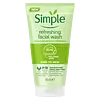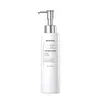What's inside
What's inside
 Key Ingredients
Key Ingredients

 Benefits
Benefits

 Concerns
Concerns

 Ingredients Side-by-side
Ingredients Side-by-side

Water
Skin ConditioningPotassium Cocoyl Glycinate
Polyglycerin-10
HumectantGlycerin
HumectantTea-Cocoyl Glutamate
CleansingSodium PCA
HumectantLauryl Hydroxysultaine
CleansingTuber Magnatum Extract
Skin ConditioningSodium Lauryl Glycol Carboxylate
CleansingArginine
Masking1,2-Hexanediol
Skin ConditioningHydroxyacetophenone
AntioxidantSodium Chloride
MaskingHydroxypropyl Methylcellulose
Emulsion StabilisingHyaluronic Acid
HumectantCeramide EOP
Skin ConditioningCeramide Ns
Skin ConditioningCeramide NP
Skin ConditioningCeramide As
Skin ConditioningCeramide AP
Skin ConditioningDisodium Cocoamphodiacetate
CleansingCentella Asiatica Extract
CleansingDisodium Cocoyl Glutamate
CleansingSodium Taurine Cocoyl Methyltaurate
CleansingXylitylglucoside
HumectantAnhydroxylitol
HumectantGlyceryl Oleate
EmollientSorbitan Caprylate
EmulsifyingPPG-26-Buteth-26
Skin ConditioningTetrasodium Glutamate Diacetate
PEG-40 Hydrogenated Castor Oil
EmulsifyingPotassium Chloride
Xylitol
HumectantHexylene Glycol
EmulsifyingSericin
Skin ConditioningCaprylhydroxamic Acid
Tetrasodium EDTA
Hamamelis Virginiana Water
AstringentParfum
MaskingPortulaca Oleracea Extract
Skin ConditioningButylene Glycol
HumectantEthylhexylglycerin
Skin ConditioningLaminaria Digitata Extract
Skin ProtectingHydrogenated Lecithin
EmulsifyingPhenoxyethanol
PreservativeCholesterol
EmollientCetyl-Pg Hydroxyethyl Palmitamide
Skin ConditioningWater, Potassium Cocoyl Glycinate, Polyglycerin-10, Glycerin, Tea-Cocoyl Glutamate, Sodium PCA, Lauryl Hydroxysultaine, Tuber Magnatum Extract, Sodium Lauryl Glycol Carboxylate, Arginine, 1,2-Hexanediol, Hydroxyacetophenone, Sodium Chloride, Hydroxypropyl Methylcellulose, Hyaluronic Acid, Ceramide EOP, Ceramide Ns, Ceramide NP, Ceramide As, Ceramide AP, Disodium Cocoamphodiacetate, Centella Asiatica Extract, Disodium Cocoyl Glutamate, Sodium Taurine Cocoyl Methyltaurate, Xylitylglucoside, Anhydroxylitol, Glyceryl Oleate, Sorbitan Caprylate, PPG-26-Buteth-26, Tetrasodium Glutamate Diacetate, PEG-40 Hydrogenated Castor Oil, Potassium Chloride, Xylitol, Hexylene Glycol, Sericin, Caprylhydroxamic Acid, Tetrasodium EDTA, Hamamelis Virginiana Water, Parfum, Portulaca Oleracea Extract, Butylene Glycol, Ethylhexylglycerin, Laminaria Digitata Extract, Hydrogenated Lecithin, Phenoxyethanol, Cholesterol, Cetyl-Pg Hydroxyethyl Palmitamide
 Reviews
Reviews

Ingredients Explained
These ingredients are found in both products.
Ingredients higher up in an ingredient list are typically present in a larger amount.
Glycerin is already naturally found in your skin. It helps moisturize and protect your skin.
A study from 2016 found glycerin to be more effective as a humectant than AHAs and hyaluronic acid.
As a humectant, it helps the skin stay hydrated by pulling moisture to your skin. The low molecular weight of glycerin allows it to pull moisture into the deeper layers of your skin.
Hydrated skin improves your skin barrier; Your skin barrier helps protect against irritants and bacteria.
Glycerin has also been found to have antimicrobial and antiviral properties. Due to these properties, glycerin is often used in wound and burn treatments.
In cosmetics, glycerin is usually derived from plants such as soybean or palm. However, it can also be sourced from animals, such as tallow or animal fat.
This ingredient is organic, colorless, odorless, and non-toxic.
Glycerin is the name for this ingredient in American English. British English uses Glycerol/Glycerine.
Learn more about GlycerinThis ingredient is a semi-synthetic polymer created from cellulose. In case you need a refresher, cellulose is the main component of plant cell walls.
Hydroxypropyl Methylcellulose has many uses:
- emulsifier
- create a gel-like texture
- boost foam
Phenoxyethanol is a preservative that has germicide, antimicrobial, and aromatic properties. Studies show that phenoxyethanol can prevent microbial growth. By itself, it has a scent that is similar to that of a rose.
It's often used in formulations along with Caprylyl Glycol to preserve the shelf life of products.
Chances are, you eat sodium chloride every day. Sodium Chloride is also known as table salt.
This ingredient has many purposes in skincare: thickener, emulsifier, and exfoliator.
You'll most likely find this ingredient in cleansers where it is used to create a gel-like texture. As an emulsifier, it also prevents ingredients from separating.
There is much debate on whether this ingredient is comedogenic. The short answer - comedogenic ratings don't tell the whole story. Learn more about comegodenic ratings here.
The concensus about this ingredient causing acne seems to be divided. Research is needed to understand if this ingredient does cause acne.
Scrubs may use salt as the primary exfoliating ingredient.
Learn more about Sodium ChlorideWater. It's the most common cosmetic ingredient of all. You'll usually see it at the top of ingredient lists, meaning that it makes up the largest part of the product.
So why is it so popular? Water most often acts as a solvent - this means that it helps dissolve other ingredients into the formulation.
You'll also recognize water as that liquid we all need to stay alive. If you see this, drink a glass of water. Stay hydrated!
Learn more about Water